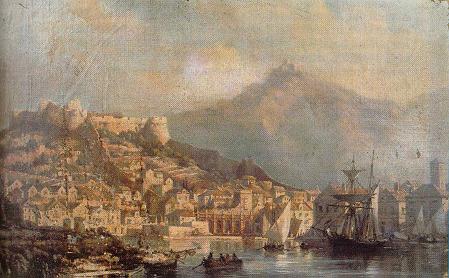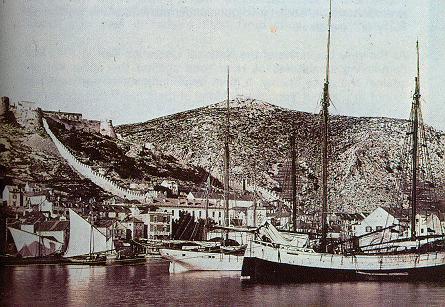

The early colonisation of this part of the island was conditioned by the long, accessible and sheltered bay of the town of Hvar, the soft landscape and coast, and a mild climate. The area in the immediate vicinity of Hvar was inhabited by a high neolithic culture more than 7000 years ago. The evidence for this was found in Marco's cave on the cape of Pelegrin, 20 minutes walk from the town of Hvar. Many items of ceramics, tools, and weapons were found there.
The continuity of existence of the Hvar settlement can be traced from then up to Illyrian times. The Illyrians inhabited the island during the 2nd millennium BC. Fortifications and sepulchral mounds which are situated under the medieval fortress and on the Paklinski islands are the material vestiges of their culture.
The Greek settlement in the vicinity of Hvar can be confirmed only by the discovery of coins. It is indisputable though that the settlement existed, especially because of its geographical advantages and importance as a centre for communications.
The Roman settlement was situated in the valley of Dolac, from in front of the cathedral up to the summer villa of Hanibal Lucic, and southwards, along the edges of today's main square, framing the city harbour (in ancient times the sea came up to the cathedral, which indicates that the square was an inlet of the sea). The Roman colonisation continued on the Greek site, but the area was broader since the Roman style of life was more rural. Therefore, there are many remains of the Roman villa rusticate in the area of today's fields near Hvar.
The remains of ancient monuments can be found on the Paklinski islands and in
the sea near Hvar which all confirm intensive navigation and commerce. The
town from the late ancient period developed on the slopes of the northern hill
where the Illyrian ruins were, and later the medieval town was founded there.
In the 17th and 18th centuries Hvar was under the rule of Neretva. Today
there are very few architectural remains to indicate the existence of this
influence in the area called Burag (Burak).

Today's old town is situated on two hills which are connected by the main
square. The town started forming after 1278 when Venice conditioned the
building of the town with the construction of the fortress, its walls, and the
public buildings, which give the special atmosphere to the town. In the 15th
century the part of the town called Grad, situated below the fortress and
surrounded by the walls, became too confined, so the settlement extended to
the south hill where the suburb of Burag were founded. These two urban
agglomerations are connected by the square. On the east they are bounded by
the
cathedral
and on the west by the
arsenal, the Governor's Palace and
mandrac (enclosed marina), forming the medieval perimeter of the town. The
second half of the 13th century, i.e. after 1278, was when Hvar took over the
dominant role on the island and became the centre of the community. Being the
main point for communications and commerce with the municipal and church
administration, Hvar became the centre of the economic, political and
cultural life on the island. Hvar had an important role in the Venetian state
owing to its exceptional position as regards communications, i.e. navigation
both up and down, and across, the Adriatic and Mediterranean Seas. It made
possible its prosperity and expansion, which lasted from the 13th to the 17th
century, after which there was a degree of stagnation for Hvar and the
islands itself up to the second half of the 19th century. Tourism and other
aspects of the economy then began to develop.